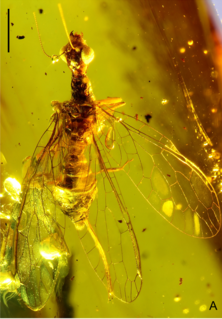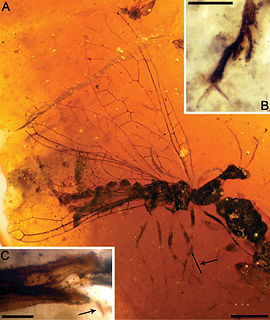
Snakeflies are a group of predatory insects comprising the order Raphidioptera with two extant families: Raphidiidae and Inocelliidae, consisting of roughly 260 species. In the past, the group had a much wider distribution than it does now; snakeflies are found in temperate regions worldwide but are absent from the tropics and the southern hemisphere. They are a relict group and have been considered living fossils, as species from the early Jurassic period closely resemble modern-day species.

Nanoraphidia is an extinct genus of snakefly in the family Mesoraphidiidae containing the species Nanoraphidia electroburmica and Nanoraphidia lithographica.
Fibla carpenteri is an extinct species of snakefly in the Inocelliidae genus Fibla. F. carpenteri is named in honor of the paleoentomologist Dr Frank Carpenter, for his vast knowledge and interest in Raphidioptera.
Florissantoraphidia funerata is an extinct species of snakefly, originally assigned to the raphidiid genus Raphidia, but subsequently transferred to the genus Florissantoraphidia. The name F. funerata is derived from the Latin funeratus meaning to "bury" or "intern". The species is known from a single female specimen, the holotype, deposited in the Department of Palaeontology at the Natural History Museum in London as specimen number "In. 26922". Though they did not study the specimen, Horst Aspöck, Ulrike Aspöck and Hubert Rausch in the 1991 work Die Raphidiopteren der Erde noted and figured the specimen as an "unidentified raphidiid". Dr. Michael S. Engel first studied and described the species after finding the specimen in the Department of Palaeontology collections. He published his type description in the journal Transactions of the Kansas Academy of Science in 2003.
Ororaphidia is an extinct genus of snakefly containing two species: the type species Ororaphidia megalocephala and Ororaphidia bifurcata.

Styporaphidia is a genus of snakefly, belonging to the extinct family Mesoraphidiidae, containing up to two species, the type species Styporaphidia magia and tentatively Styporaphidia? hispanica. The genus was named from the Greek stypos meaning "stem" or "stump" and Raphidia, the type genus for, and most often used as, a stem for generic names in the order Raphidioptera. The species name of S. magia is from the Greek word mageia meaning "magic" while the species name for S.? hispanica is from the Latin Hispania meaning "Spain" in reference to the type locality of the species.

Archiinocellia is an extinct genus of Snakefly in the family Raphidiidae known from Eocene fossils found in western North America. The genus contains two species, the older Archiinocellia oligoneura and the younger Archiinocellia protomaculata. The type species is of Ypresian age and from the Horsefly Beds of British Columbia, while the younger species from the Lutetian Green River Formation in Colorado. Archiinocellia protomaculata was first described as Agulla protomaculata, and later moved to Archiinocellia.
Proraphidia is a genus of snakefly in the extinct family Mesoraphidiidae. The genus currently contains three species; Proraphidia gomezi from the La Pedrera de Rúbies Formation in Spain, Proraphidia hopkinsi from the Weald Clay in England, and the type species Proraphidia turkestanica from Kazakhstan. The genus was first described by O. M. Martynova in 1941 with the publication of P. turkestanica from Jurassic deposits of the Karabastau Formation in Karatau, Kazakhstan.
Kachinus is an extinct genus of ant-like stone beetle in the family Staphylinidae containing the single species Kachinus antennatus.

Plumalexius is a genus of wasps in the extinct monotypic family Plumalexiidae, containing two species: the type species Plumalexius rasnitsyni, known from the Late Cretaceous White Oaks Pit in Sayreville, New Jersey, and Plumalexius ohmkuhnlei, known from the Cretaceous Burmese amber.

Necroraphidia is an extinct genus of snakefly in the family Mesoraphidiidae. The genus is solely known from Early Cretaceous, Albian age, fossil amber found in Spain. Currently the genus comprises a single species, Necroraphidia arcuata.

Amarantoraphidia is an extinct genus of snakefly in the family Mesoraphidiidae. The genus is solely known from Early Cretaceous, Albian age, fossil amber found in Spain. Currently the genus comprises only a single species Amarantoraphidia ventolina.

Alavaraphidia is an extinct genus of snakefly in the family Mesoraphidiidae. The genus is solely known from an Early Cretaceous, Albian age, fossil amber found in Spain. Currently, the genus comprises a single species, Alavaraphidia imperterrita.

Cantabroraphidia is an extinct genus of snakefly in the family Mesoraphidiidae. The genus is solely known from fossil amber found in Cantabria, northern Spain, dating to the Albian age of the Early Cretaceous Period. Currently the genus comprises a single species Cantabroraphidia marcanoi.

Mesoraphidiidae is an extinct family of snakeflies in the suborder Raphidiomorpha. The family lived from the Late Jurassic through the Late Cretaceous and is known from twenty-five genera. Mesoraphidiids have been found as both compression fossils and as inclusions in amber. The family was first proposed in 1925 by the Russian paleoentomologist Andrey Vasilyevich Martynov based on Upper Jurassic fossils recovered in Kazakhstan. The family was expanded in 2002 by the synonymizing of several other proposed snakefly families. The family was divided into three subfamilies and one tribe in a 2011 paper, further clarifying the relationships of the included genera.
Iberoraphidia is an extinct genus of snakefly in the family Mesoraphidiidae. The genus is solely known from a Cretaceous, Lower Barremian, fossil found in Spain. Currently the genus is composed of a single species, Iberoraphidia dividua.

Brownimecia is an extinct genus of ants, the only genus in the tribe Brownimeciini and subfamily Brownimeciinae of the Formicidae. Fossils of the single identified species, Brownimecia clavata, are known from the Middle Cretaceous of North America. The genus is one of several ants described from Middle Cretaceous ambers of New Jersey. Brownimecia was initially placed in the subfamily Ponerinae, until it was transferred to its own subfamily in 2003; it can be distinguished from other ants due to its unusual sickle-like mandibles and other morphological features that makes this ant unique among the Formicidae. The ant is also small, measuring 3.43 millimetres (0.135 in), and a stinger is present in almost all of the specimens collected. The morphology of the mandibles suggest a high level of feeding specialization.

Burmomyrma is an extinct genus of ant-mimic wasp in the extinct family Falsiformicidae. The genus contains a single described species, Burmomyrma rossi. Burmomyrma is known from a single Middle Cretaceous fossil which was found in Asia.
Zigrasolabis is an extinct genus of earwig in the family Labiduridae known from Cretaceous fossils found in Myanmar. The genus contains a single described species, Zigrasolabis speciosa.
This list of fossil arthropods described in 2012 is a list of new taxa of trilobites, fossil insects, crustaceans, arachnids and other fossil arthropods of every kind that have been described during the year 2012. The list only includes taxa at the level of genus or species.










